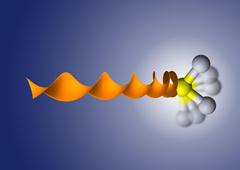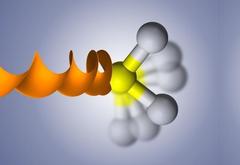URL: https://www.desy.de/news/news_search/index_eng.html
Breadcrumb Navigation
DESY News: Novel corkscrew-laser technique can send molecules spinning rapidly about a selected axis
News
News from the DESY research centre
Novel corkscrew-laser technique can send molecules spinning rapidly about a selected axis
Using corkscrew-shaped laser pulses, scientists at DESY have devised a sophisticated optical centrifuge that can make molecules rotate rapidly about a desired molecular axis. The innovative method opens up new ways to control and study super fast spinning molecules, called superrotors. Until now, optical centrifuges can make molecules rotate about one specific axis only. The new scheme lets scientists select between two axes. Alec Owens, Andrey Yachmenev and Jochen Küpper from the Controlled Molecule Imaging (CMI) Group at the Center for Free-Electron Laser Science (CFEL) report their theoretical concept in The Journal of Physical Chemistry Letters.

Optical centrifuges are made of corkscrew-shaped laser pulses that can make molecules rotate extremely fast (artist's impression). Credit: DESY
“Controlling ultrafast rotational motion of molecules has seen tremendous progress in recent years thanks to the development of innovative techniques in strong-field laser physics,” says Owens, who is also affiliated with the Hamburg Center for Ultrafast Imaging CUI. Existing optical centrifuges always trap molecules along the axis where the electric charges of the molecule can most easily be shaken around to form a so-called dipole. The molecule’s axis then follows the rotating laser field and starts spinning faster and faster.
The CMI team now developed a method that uses a corkscrew laser that is repeatedly turned on and off. This modified optical centrifuge allows the axis about which the molecule rotates to be selected. Using the example of hydrogen sulfide (H2S), the study demonstrates how the rotation of asymmetric molecules can be controlled, choosing between two distinct molecular axes. Turning the corkscrew laser on and off can be achieved by adding a modifying pulse envelope that is superimposed to the laser field. This way the molecules can be excited along different pathways of rotational states, ultimately leading to rotation about one of two different axes.
“Such a scheme to control the angular momentum alignment of a molecule will be useful in studies of molecule-molecule or molecule-surface scattering, where you can change the outcome and study the stereodynamics of a scattering event by controlling the rotation axis,” explains Yachmenev. Equally beneficial is the large amount of energy associated with superrotors, which can be controlled by changing the duration of the optical centrifuge pulse.
CFEL is a cooperation of DESY, the Max Planck Society and Universität Hamburg. CUI is a Cluster of Excellence at Universität Hamburg within the German federal excellence strategy.
Reference:
„Coherent Control of the Rotation Axis of Molecular Superrotors“; A. Owens, A. Yachmenev, and J. Küpper; „The Journal of Physical Chemistry Letters“, 2018; DOI: 10.1021/acs.jpclett.8b01689
Weitere Informationen:
Controlled Molecule Imaging Group am Center for Free-Electron Laser Science: https://www.controlled-molecule-imaging.org




